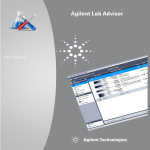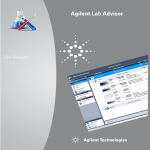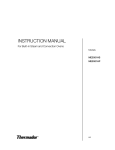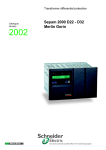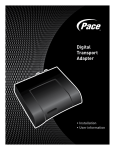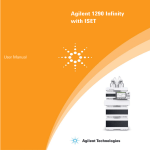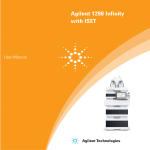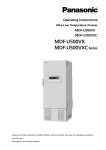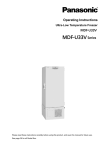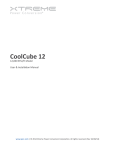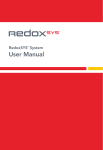Download Lab Advisor User Manual
Transcript
Agilent Lab Advisor User Manual Agilent Technologies Notices © Agilent Technologies, Inc. 2012 Warranty No part of this manual may be reproduced in any form or by any means (including electronic storage and retrieval or translation into a foreign language) without prior agreement and written consent from Agilent Technologies, Inc. as governed by United States and international copyright laws. The material contained in this document is provided “as is,” and is subject to being changed, without notice, in future editions. Further, to the maximum extent permitted by applicable law, Agilent disclaims all warranties, either express or implied, with regard to this manual and any information contained herein, including but not limited to the implied warranties of merchantability and fitness for a particular purpose. Agilent shall not be liable for errors or for incidental or consequential damages in connection with the furnishing, use, or performance of this document or of any information contained herein. Should Agilent and the user have a separate written agreement with warranty terms covering the material in this document that conflict with these terms, the warranty terms in the separate agreement shall control. Manual Part Number M8550-90002 Edition 07/2012 Printed in Germany Agilent Technologies Hewlett-Packard-Strasse 8 76337 Waldbronn This product may be used as a component of an in vitro diagnostic system if the system is registered with the appropriate authorities and complies with the relevant regulations. Otherwise, it is intended only for general laboratory use. receive no greater than Restricted Rights as defined in FAR 52.227-19(c)(1-2) (June 1987). U.S. Government users will receive no greater than Limited Rights as defined in FAR 52.227-14 (June 1987) or DFAR 252.227-7015 (b)(2) (November 1995), as applicable in any technical data. Safety Notices CAUTION A CAUTION notice denotes a hazard. It calls attention to an operating procedure, practice, or the like that, if not correctly performed or adhered to, could result in damage to the product or loss of important data. Do not proceed beyond a CAUTION notice until the indicated conditions are fully understood and met. Technology Licenses The hardware and/or software described in this document are furnished under a license and may be used or copied only in accordance with the terms of such license. Restricted Rights Legend If software is for use in the performance of a U.S. Government prime contract or subcontract, Software is delivered and licensed as “Commercial computer software” as defined in DFAR 252.227-7014 (June 1995), or as a “commercial item” as defined in FAR 2.101(a) or as “Restricted computer software” as defined in FAR 52.227-19 (June 1987) or any equivalent agency regulation or contract clause. Use, duplication or disclosure of Software is subject to Agilent Technologies’ standard commercial license terms, and non-DOD Departments and Agencies of the U.S. Government will WA R N I N G A WARNING notice denotes a hazard. It calls attention to an operating procedure, practice, or the like that, if not correctly performed or adhered to, could result in personal injury or death. Do not proceed beyond a WARNING notice until the indicated conditions are fully understood and met. Lab Advisor User Manual Contents Contents 1 Lab Advisor B.02.03 Overview 2 Installation 5 7 Prerequisites 8 Deployment Modes 10 Hard drive installation 11 Server Installation 16 Running Lab Advisor from the CD-ROM 17 Updating Lab Advisor 18 Migrating from Lab Advisor B.01.xx 19 3 Using Lab Advisor 21 Navigation 22 System Overview 26 Configuration 32 Apps 37 Firmware Update 42 Logs and Results 43 Service and Diagnostics Instrument Control 48 EMFs 53 Status Report 55 Lab Advisor User Manual 46 3 Contents 4 Lab Advisor User Manual Lab Advisor User Manual 1 Lab Advisor B.02.03 Overview This chapter describes the two versions of Lab Advisor B.02.03: Lab Advisor Basic and Lab Advisor Advanced. With its advanced diagnostic and maintenance capabilities, Agilent Lab Advisor helps you to keep your Agilent LC and CE instruments in top condition and thereby achieve high quality chromatographic results. Agilent Lab Advisor is an application- independent tool: it can support Agilent LC and CE instrumentation regardless of whether you are using Agilent or non-Agilent software to control the instruments. The Agilent Lab Advisor is available in two flavors: Lab Advisor Basic and Lab Advisor Advanced. Agilent Technologies 5 1 6 Lab Advisor B.02.03 Overview Lab Advisor User Manual Lab Advisor User Manual 2 Installation Prerequisites 8 Deployment Modes 10 Hard drive installation Server Installation 11 16 Running Lab Advisor from the CD-ROM Updating Lab Advisor 17 18 Migrating from Lab Advisor B.01.xx 19 This chapter contains instructions for installing Lab Advisor.B.02.01. Under construction Agilent Technologies 7 2 Installation Prerequisites Prerequisites Agilent Lab Advisor can run on any Microsoft Windows XP or Windows 7 PC with Microsoft .NET 2.0 or higher installed. The software has been extensively tested with the following software packages: Table 1 Supported Software List Element Revision Windows XP Pro SP3 Windows 7 32 bit Windows 7 64 bit Windows Server 2008 R2 Internet Explorer 7.0 Internet Explorer 8.0 .Net Framework 2.0 and higher Symantec Antivirus 11.0 Adobe Acrobat 9.0 For optimum performance of your Agilent Lab Advisor software, the following minimum requirements should be fulfilled. The minimum supported configuration is based on the installation on a Netbook, but for larger installations, or for higher performance, the recommended configuration should be used. Table 2 8 PC Hardware Configurations Minimum (Netbook) Configuration Recommended Configuration Processor Intel Atom processor Pentium D or higher, Intel Dual-Core 3.4GHz or higher RAM 1.0 GB or more ≥ 1 GB (Windows XP SP3 Pro) ≥ 2 GB (Windows 7) Lab Advisor User Manual Installation Prerequisites Table 2 PC Hardware Configurations Minimum (Netbook) Configuration Recommended Configuration Hard disc 1 GB 160 GB or bigger Video 1024 × 600 resolution 1280 × 1024 resolution Removable media (external) CD-Rom drive DVD drive Mouse MS Windows compatible pointing device MS Windows compatible pointing device LAN 10/100baseT 10/100baseT Operating Systems Windows 7 Starter Windows XP Pro Service Pack 3 Windows 7 Windows Server 2008 R2 for server installations Printer all printers supported by the operating system in use all printers supported by the operating system in use Lab Advisor User Manual 2 9 2 Installation Deployment Modes Deployment Modes Lab Advisor can be deployed in four different modes: Table 3 Lab Advisor Deployment Modes Mode Installation Start Data location Standard Installed on the local hard drive using setup.exe, see “Hard drive installation” on page 11. Run from desktop icon or Windows Start menu. Standard: ..\Agilent Lab Advisor\ AgilentLabAdvisorData\... Server Installed on Windows Server 2008 using setup.exe and published as a shareable application, see “Server Installation” on page 16. Run using RDP link at clients' desktops. ..\Agilent Lab Advisor\ AgilentLabAdvisorData-[TerminalHostName]\... Instant No installation required. Run AgiInstrDiag.exe from the installation CD, see “Running Lab Advisor from the CD-ROM” on page 17 Standard: ..\Agilent Lab Advisor\ AgilentLabAdvisorData\... 10 Lab Advisor User Manual Installation Hard drive installation 2 Hard drive installation 1 Double-click the Setup.exe icon to start the installation. The Choose Language dialog box is displayed. 2 Click the down-arrow and select the language from the list and click OK. Lab Advisor supports English, Chinese and Japanese. The first page of the installation wizard is displayed. NOTE You can change the language after installation, see “Language” on page 32 Lab Advisor User Manual 11 2 Installation Hard drive installation 3 Click Install. The License Agreement is displayed. 4 Select to accept the terms of the license and click Next. The Custom Setup page of the installation wizard is displayed. 5 If you want to change the default location, click Browse to select a new location; otherwise, click Next. The last page of the installation wizard is displayed. 12 Lab Advisor User Manual Installation Hard drive installation 2 6 Mark the check boxes against the options you want to activate and click Next. Restore old data restores old data from either B.01.xx installations or from previous B.02.xx installations. The data is not removed from the hard drive during de-installation, but if Restore old Data is cleared, the old data is permanently removed from the hard drive. If the Launch the Agilent Installation Qualification Tool check box was marked, the Agilent IQT tool launches automatically. To start the Installation Qualification click Qualify. The Installation Qualification Report is opened in a browser window and can be printed. To access the report at a later time, go to \Program Files\Agilent Technologies\Lab Advisor\IQTool\IQProducts\Agilent Lab Advisor LC & CE\Reports. Lab Advisor User Manual 13 2 Installation Hard drive installation To rerun the Installation Qualification at a later date, navigate to Start\All programs\Agilent Lab Advisor\Installation Qualification and start the program. When you close the IQ tool, the installation is complete. 14 Lab Advisor User Manual Installation Hard drive installation 2 If the Enter License check box was marked in the installation wizard, the software starts and automatically navigates to the Configuration\License screen, where you can enter your the license keys. Lab Advisor User Manual 15 2 Installation Server Installation Server Installation You can install Lab Advisor on a Windows Server 2008 server and make it available for use on client systems. 1 Install Lab Advisor on the Windows Server 2008 server as described in “Hard drive installation” on page 11. 2 Install the role Remote Desktop Services on the Windows Server 2008 server. 3 Publish the Lab Advisor installation on the Windows Server 2008 server. 4 Create an RDP (Remote Desktop Protocol) file for the Lab Advisor installation. 5 Distribute the RDP file to all client systems. 16 Lab Advisor User Manual 2 Installation Running Lab Advisor from the CD-ROM Running Lab Advisor from the CD-ROM When you run Lab Advisor from the CD-ROM, no program files are copied to the local hard drive. However, any data that you generate will be saved in a folder ..\Agilent Lab Advisor\ AgilentLabAdvisorData\ on the local hard drive. 1 Insert the Lab Advisor installation CD-ROM into the drive. 2 Double-click the Instant Diagnostic item in the root directory of the CD-ROM. Lab Advisor User Manual 17 2 Installation Updating Lab Advisor Updating Lab Advisor A fast update process has been developed to update the Agilent Lab Advisor software to a new revision. The fast update process uses .DLA files, and is launched by double-clicking the file itself. An update using the fast update process requires files specific to the update required. The file name carries the name of the origin and the destination revisions, and must be selected accordingly. For example, to update from Lab Advisor B.02.02 [042] to B.02.03 [062], double-click the following .DLA file: LA_B.02.02[042]_B.02.03[062].dla The fast update using .DLA files cannot be used to update portable installations of the software. To upgrade these installations, the upgraded software of a hard drive installation needs to be copied to the portable media. It is highly recommended that you rename the old application folder before copying the updated software folder. After finishing the copy of the application folder, the data folder can be copied from the “old” application folder. 18 Lab Advisor User Manual 2 Installation Migrating from Lab Advisor B.01.xx Migrating from Lab Advisor B.01.xx It is possible to migrate data and licenses from B.01.xx installations to B.02.xx. To do this, the B.01.xx has to be uninstalled, since the uninstallation process creates a data repository that can be used by the B.02.xx installer. To access the old data, mark the Restore old Data check box during the installation process. If B.01.xx is uninstalled after the installation of the B.02.xx, then the restore can be activated by navigating to the application folder, typically ..\Program Files\Agilent Technologies\Lab Advisor and double-clicking the Agilent.InstrDiag.DataMigration.exe program. Lab Advisor User Manual 19 2 20 Installation Migrating from Lab Advisor B.01.xx Lab Advisor User Manual Lab Advisor User Manual 3 Using Lab Advisor Navigation 22 System Overview 26 Adding a new system 26 Changing system properties 27 Removing a system 28 Adding a new system group 29 Deleting a system group 29 Moving systems between groups 29 Copying Device Details to the Clipboard Fast Connect 30 Configuration 32 Configuring the Software Licenses 33 Traceability 35 Apps 37 Diagnostic Catalog Data Sharing 38 Firmware Update 42 Logs and Results 43 Service and Diagnostics Instrument Control EMFs 30 32 37 46 48 53 Status Report 55 This chapter describes the Lab Advisor user interface and provides details about the available features. Agilent Technologies 21 3 Using Lab Advisor Navigation Navigation The Lab Advisor User Interface is divided into six main areas. The content of these areas changes depending on the screen selected in the Agilent Lab Advisor software. I^iaZ7Vg >c[dgbVi^dcEVcZa <adWVaHXgZZch HnhiZbHXgZZch 6eea^XVi^dcEVcZa CVk^\Vi^dcEVcZa =ZaeIde^Xh <gdje8dcigdah 6Xi^dcEVcZa HiVijh7Vg Title Bar The Title Bar shows which of the configured systems in the System Overview is currently selected. It also hosts the buttons for maximizing, minimizing and closing the Agilent Lab Advisor application. 22 Lab Advisor User Manual Using Lab Advisor Navigation 3 Navigation Panel The primary navigation between the different screens of the Lab Advisor software is done in the Navigation Panel. The Navigation Panel consists of three areas: • The Global Tasks lists system-independent screens that access information or configurations regardless of the configured systems and their current state. • The System Tasks are System-specific and change with the selected system. The name of the selected system is displayed in the header of the System Tasks and in the Title Bar. Lab Advisor User Manual 23 3 Using Lab Advisor Navigation • At the bottom of the Navigation Panel, the Help topics provide information about the software and about the individual screens. Context-sensitive help topics can also be accessed at any time by clicking F1. The Navigation Panel can be minimized by clicking the minimize icon in the top Task bar. Information Panel The Information Panel contains information about the currently selected screen and the Agilent Lab Advisor software version. If the Traceability feature is in use, the Information Panel also includes information about the current logged-in user. Application Panel This is the primary area where the different screens selected in the Navigation Panel of the Agilent Lab Advisor software are displayed, Refer to the individual applications for more detailed information. Group Controls If system grouping has been activated in software configuration, these controls allow you to switch between system groups, and to add a new system group or delete an existing group. Action Panel Additional buttons or actions that are applicable to the selected screen may be displayed in the Action Panel. Such controls are applicable to the entire selected screen; buttons or actions that are applicable to individual items within the screen are displayed in the screen itself. Status Bar 24 Lab Advisor User Manual 3 Using Lab Advisor Navigation The left side of the Status Bar contains information about the connection used; details about the Agilent Lab Advisor revision, license level and license usage are shown on the right side. Lab Advisor User Manual 25 3 Using Lab Advisor System Overview System Overview The System Overview screen gives a fast overview of the state of all configured and connected systems. The System Overview is also the main selection screen for the System Tasks. Adding a new system 1 In the Action Panel of the System Overview, click Add System. The Add System dialog box is displayed. 26 Lab Advisor User Manual Using Lab Advisor System Overview 3 2 In the Add System dialog box, enter a name for the system in the System Name field and the connection details in the Connection Address field. NOTE The connection details can be an IP address, the host name or, if you are connecting using a serial cable, the COM port. 3 Click the Type down-arrow and select the type of system you are adding from the list. 4 Click OK to finish adding the system and close the Add System dialog box. The system becomes visible in the System Overview, and Lab Advisor tries to connect to it. Changing system properties You can change the name or connection address of an existing system, add additional information or activate the automatic Reconnect feature for the system. 1 Click on the system in the System Overview screen to select it. 2 Click System Properties in the Action Panel. OR Right-click on the system and select Properties from the context menu. The System Properties dialog box is displayed. Lab Advisor User Manual 27 3 Using Lab Advisor System Overview Note that the System Group field is present only when the Activate Grouping check box in the Configuration - Software screen is marked. 3 Add or modify any of the parameters in the System Properties dialog box. NOTE When you mark the Reconnect check box, Agilent Lab Advisor automatically tries to connect to the system whenever the application is launched. This feature can be activated for all systems configured in the System Overview simultaneously. 4 Click Apply to register the changes and close the System Properties dialog box. Removing a system 1 Click on the system in the System Overview screen to select it. 2 Click Remove System in the Action Panel. The system is removed from the System Overview. NOTE The data collected for the system will still be available in the Logs and Results application, but will be listed as unassigned systems. Systems that have been removed from the System Overview are still counted toward the module limit of the installed license. To permanently delete a module, see “Permanently deleting a hardware module” on page 34. 28 Lab Advisor User Manual 3 Using Lab Advisor System Overview Adding a new system group NOTE The system group controls are available only when the Activate Grouping check box in the Configuration - Software screen is marked. 1 Click at the right of the group controls. A new system group tab is added with a default name. 2 Right-click on the new tab, select Rename from the context menu and overwrite the default name with a new name. OR Double-click on the new tab and overwrite the default name with a new name. 3 Click Add System to display the Add System dialog box, which allows you add a system into the new system group. Deleting a system group NOTE You cannot delete a system group that contains systems. Before deleting a group, move the systems into another group (see “Moving systems between groups” on page 29). 1 Right-click on the tab of the system group that you want to delete. 2 Select Delete from the context menu. If the system group is empty, it is deleted; if the group contains systems, a message is displayed. Moving systems between groups 1 In the System Overview, select the system that you want to move and click System Properties. OR Lab Advisor User Manual 29 3 Using Lab Advisor System Overview In the System Overview, right-click the system that you want to move and select Properties from the context menu. The System Properties dialog box is displayed. 2 Click the System Group down-arrow and select the target group that you want to move the system to. 3 Click Apply. The system is moved from the existing group to the new group and the System Properties dialog box is closed. Copying Device Details to the Clipboard Sometimes, it can be helpful to have the details presented in the System Information section of a device available for copying and pasting into other applications. 1 Click on the system in the System Overview screen to select it. 2 If the system modules are not listed, click to display them. 3 Right-click on the module whose details you want to copy and select Copy details to Clipboard from the context menu. The device information is copied to the clipboard, and can be pasted into another application such as Notepad, Wordpad or a Microsoft Office application. Fast Connect If you are using mobile laptop computers for servicing systems, a fast connection can be established using a serial cable (RS232). 1 Connect the serial cable between the system and the PC (a USB-to-Serial adapter, p/n 8121-1013, might be necessary). The serial cable should be connected to the module that is providing the most data, usually the detector. 2 Click Connect via Serial Cable on the Action Panel. Lab Advisor searches all available COM ports for installed systems and adds them automatically to the System Overview screen. 30 Lab Advisor User Manual Using Lab Advisor System Overview 3 Lab Advisor can also be setup to do this automatically on startup by marking the On startup check box in the Action Panel. NOTE This feature is especially helpful for connecting systems with no LAN access, because it provides easy access to data such as LAN card configuration, MAC address and IP address without having to reconfigure the Laptop internal IP address or set up a BootP server. Lab Advisor User Manual 31 3 Using Lab Advisor Configuration Configuration Application-wide settings, information and tools are accessible from the Configuration screen. Configuring the Software The Software configuration specifies the Path to the data generated by the Lab Advisor software. This is a non-configurable path, and is dependent on the operating system used and the type of installation (USB stick or hard drive). Import/Export Data To distribute configured systems and their corresponding data, it is possible to export data from one Lab Advisor installation and import it into other installations. This feature can also be used as a backup solution, where the exported .ZIP file is stored in a safe location. Tracing If unexpected behavior is observed from the Lab Advisor software, a trace file can be generated to help the Agilent Technologies technicians locate the problem. You can also switch on the continuous collection of all instrument communication data. This form of logging does not persist beyond the current Lab Advisor session. Language The Lab Advisor software supports English, Chinese and Japanese languages. The language is usually selected during installation of the software. However, there is a possibility to change the language later by selecting the appropriate language in the Software configuration screen. After the language has been changed, the software needs to be restarted for the new settings to take effect. 32 Lab Advisor User Manual 3 Using Lab Advisor Configuration System Groups Lab Advisor B.02.03 supports the grouping of systems, for example, by laboratory. Up to 25 systems can be assembled into a group; each system can contain up to 50 devices. An unlimited number of groups can be defined. The grouping of systems is switched on by marking the Activate Grouping check box. When the check box is marked, the group controls (see “Group Controls” on page 24) are appended to the application panel in the System Overview and the Review Client. Licenses The licensing scheme of Lab Advisor B.02.xx has changed compared to previous versions. The unique combinations of Type and Serial number for each configured device are counted and tracked in the license module of the software. For each configured device, a license is deducted from the total number of eligible devices; the license status can be tracked in the Status Bar. Lab Advisor licenses acquired for previous versions of Lab Advisor and Lab Monitor and Diagnostic software are still eligible for Lab Advisor B.02.xx and are transformed according to Table 4 on page 33. Table 4 Lab Advisor Licenses Product Number Description HW Modules Replaces M8550A Agilent Lab Advisor Advanced 10 G4800AA, G4809AA M8551A 5 add-on HW modules* 5 G4801AA M8552A 25 add-on HW modules* 25 G4802AA M8553A 50 add-on HW modules* 50 G4803AA M8554A 100 add-on HW modules* 100 New Lab Advisor User Manual 33 3 Using Lab Advisor Configuration Table 4 Lab Advisor Licenses Product Number Description HW Modules Replaces M8555A Agilent Lab Advisor Basic 10 Agilent Instrument Utilities LC/CE * Requires M8550A installed Any combination of the listed Product Numbers is possible, and it is also possible to install a Product Number multiple times. Each unique license number adds to the number of modules supported. Permanently deleting a hardware module If a hardware module is retired or removed from a system, it can be permanently deleted from the license count in the Agilent Lab Advisor installation by clicking Permanently delete HW module in the Licenses tab in the Configuration screen. Permanently delete HW module is active only if all systems are disconnected in the System Overview screen. The Remove HW Module window that opens lists all modules contributing to the license limit; selecting the appropriate module and pressing OK permanently deletes the selected device. NOTE 34 When a device is permanently deleted, all data belonging to the device is also permanently deleted. Lab Advisor User Manual Using Lab Advisor Configuration 3 Traceability The Traceability feature of the software logs the use of Lab Advisor and keeps track of which user did what procedure and when. This information is written into the Logs & Results and is included in the printed results. If the Data Sharing feature is used, the traceability data is also uploaded. Traceability Level Lab Advisor offers three levels of traceability. Change of traceability level requires administrator rights. For the initial setting, the user Admin is set up using the password Admin. After the first login, this password should be changed to prevent unauthorized access. The default level is No Traceability, which allows any user to access all parts of the Lab Advisor software, depending on Licenses. At this level, no user names are added to Logs & Results or printouts. Medium Traceability requires that the user be selected from a drop-down list. No password is required, and users can register and enable themselves. The selected user name is added to the printouts and Logs & Results. Full Traceability requires that the user logs in with a unique password. Users must be granted access by an Administrator before they can access the Lab Advisor software. Setting Up a New User To enable the Lab Advisor to print the user names in the reports and Log & Results, the users need to be set up. This is done in the Traceability tab of the Configuration screen. 1 Click Add at the bottom right of the Traceability screen. The Add Contact dialog box is displayed. 2 Enter the user name as it will be printed on reports, and optionally the user's email address and telephone number. Lab Advisor User Manual 35 3 Using Lab Advisor Configuration This information will be included in the User section of the Status Report. Alternatively, a new user can be added by clicking Register as new User in the Login box: If Full Traceability is active, an Administrator must activate the user before the user can use Lab Advisor: 36 Lab Advisor User Manual Using Lab Advisor Apps 3 Apps Apps are small applications designed to help you perform specific non-system-related tasks. Diagnostic Catalog Diagnostic Catalog The Diagnostic Catalog is a catalog of all tests, calibrations, tools, instrument controls and EMF counters for each module at each Lab Advisor product level. The list is filtered by Device Class (that is, instrument or module type), Device Lab Advisor User Manual 37 3 Using Lab Advisor Apps Type and Product Level. The diagnostic catalog for the selected module at the selected product level is displayed in the Results table three columns: • Tests, Calibrations and Tools available in Lab Advisor at the selected product level • Controls provided in the Instrument Control screen of Lab Advisor at the selected product level • EMF Counters shown the EMFs screen of Lab Advisor at the selected product level For the tests, calibrations and tools, a short description is provided in the Details panel below the Results table. You can retrieve more information on the test, calibration or tool by double-clicking its name, which displays the online help. You can print the diagnostic catalog for the current selection by clicking Print. Data Sharing The Data Sharing feature of the Advanced version of Lab Advisor allows multiple Lab Advisor installations to upload and synchronize the collected instrument information and data to an upload folder. When the synchronization is activated, all data and information for the systems and devices configured in the Lab Advisor installation are uploaded to a specified upload folder. If data and information for these systems and devices has already been uploaded to the upload folder, the uploaded data is merged with the existing data. Additionally, the delta between the two data sets is downloaded to the Lab Advisor installation to complement the data. This ensures that all participating Lab Advisor installations connecting to specific systems and devices have all data available regardless of which installation generated the data. The Lab Advisor installation receives data only from systems and devices configured in that installation. No other data is downloaded. You can choose to activate automatic synchronization when Lab Advisor is started up or shut down, or both. You can also choose to switch off automatic synchronization. The available options are: Never Automatic folder synchronization is turned off. 38 Lab Advisor User Manual Using Lab Advisor Apps 3 At startup When Lab Advisor is started, any updated data in the data share folder is copied automatically into the local data folder and merged with existing data. At shutdown When Lab Advisor is shut down, any updated data in the local data folder is copied automatically into the data share folder and merged with existing data. At startup and shutdown The combination of At startup and At shutdown. Review Client The complete set of data uploaded to the data share folder can be accessed by the built-in Review Client, which is started from the Data Sharing app. The Review Client additionally supports the combination of any uploaded devices from any system to allow cross-system comparison of data. This might be helpful in finding problematic systems or devices, or systems not being used efficiently. The Review Client requires the number of licenses corresponding to the number of modules hosted on the upload share. Deleting a system from the System Overview will not free usable licenses. The number of licenses entered in the normal Lab Advisor installation is reused in the Review Client, so that if you have a 10-module license installed, you will only be able to start the Review Client if there are less than 10 modules uploaded to the upload share. Lab Advisor User Manual 39 3 Using Lab Advisor Apps There are several ways to use the Review Client: • All portable Lab Advisor installations upload their data to the same folder. Each portable Lab Advisor is then up to date, and a Review Client has the opportunity to observe the entire data pool. • Each portable Lab Advisor has its own folder, which is used for back-up. By changing the share folder in the Review Client, it is possible to look into each separate user’s data. • Lab Advisor installations on local PCs connected to a single Instrument can use the synchronize function to upload data to a system-specific folder. This can be used as a backup solution, and by changing the share folder the Review Client can be used to look at each system separately. In each case, the installation starting the Review Client needs enough licenses for all uploaded modules. If system grouping has been activated in software configuration, you can set up groups of systems; the group controls allow you to switch between the 40 Lab Advisor User Manual 3 Using Lab Advisor Apps groups. The groups you set up in the Review Client are independent of those set up in the System Overview. Lab Advisor User Manual 41 3 Using Lab Advisor Firmware Update Firmware Update Lab Advisor can be used to update the device-internal software (called firmware — FW). The Firmware Update screen lists all systems configured in the System Overview screen. The devices of these systems can be updated individually, or the entire system can be updated at one time. It is also possible to update multiple systems at one time. To start the FW update procedure, select the Firmware Update tab in the global screens section of the Navigation Panel. 42 Lab Advisor User Manual Using Lab Advisor Logs and Results 3 Logs and Results The Logs & Results screen presents data collected from the configured devices, and helps to review the status of the systems or devices. The Logs & Results data includes: • Test results • Error information • FW revision and updates • EMF changes • Maintenance log entries Each line in the log shows the module identifier (type and serial number), type of information, description and a time stamp. If the Traceability feature is in use, user-generated data is logged with user name in the Message field. Lab Advisor User Manual 43 3 Using Lab Advisor Logs and Results For easy overview, you can filter the data by Instruments, Devices, Source or Time. Multiple selections are supported for Devices and Source, and can be selected by keeping Ctrl pressed while clicking the data required in the filter. The Logs & Results screen offers two modes of operation. The default mode is the Module View, which lists the devices by system, and presents the information per device. In the alternative Time View, the data is presented and sorted by time stamp. This allows for a system-wide overview of the sequence of the data. 44 Lab Advisor User Manual Using Lab Advisor Logs and Results 3 When you click Add Log Entry, you can type a log entry to the device, which is stored on the device main board. The information written to the device is limited to 50 characters; this is typically maintenance log data. The data filtered by the built-in filter can be exported in ZIP format to enable it to be distributed. This is typically helpful if remote engineers need to assess data from the system. Clicking Load external data allows you to navigate to the storage location of the ZIP file and load the exported data. NOTE You can also use Load external data to load LRS files. Lab Advisor User Manual 45 3 Using Lab Advisor Service and Diagnostics Service and Diagnostics The Service & Diagnostics screen hosts the procedures (tests, calibrations and tools) of the Lab Advisor software. To select a procedure, select the device and then select the procedure from the list. For a better overview, you can filter the type of procedure you want to use. 46 Lab Advisor User Manual Using Lab Advisor Service and Diagnostics 3 Tests Tests are procedures that result in a Passed/Failed statement, so the results of the test are compared with predefined limits. The Pump Pressure Test is an example of a test. Calibrations If internal calculations in the devices need to be corrected, calibration procedures normally take care of this. An example of a calibration is the Detector Wavelength Calibration. If you are operating in a controlled environment, this type of procedure might need to be verified. This could typically be done using a System Suitability Test. Tools Tools are procedures that have a supporting function and that do not produce a Passed/Failed statement when finished. Lab Advisor User Manual 47 3 Using Lab Advisor Instrument Control Instrument Control The Instrument Control screen allows you to control a connected system without having to have a CDS running. This might be helpful in complex diagnostic situations, where the built-in diagnostic tests do not give a definitive answer. Instrument Control in the Basic version provides only limited functionality, whereas the Advanced version provides a full set of controls and a freely configurable Signal Plot. The Reply Panel of the Instrument Control screen displays any replies generated from the device, to verify that the control used was accepted; it shows only the last three replies. In order to get a complete history of replies, click Save Session Results in the Action Panel. The reply history is saved and can be viewed in the Logs & Results screen. 48 Lab Advisor User Manual Using Lab Advisor Instrument Control 3 Actual Status Information Each device is displayed separately in the Control Panel, and provides information about actual values. If a device has several actual values to display, the more link gives access to these values. Controls When the Controls section is expanded, a complete set of buttons becomes available providing extensive control of the device. This includes setpoints, controls, special commands and module information. When the buttons are clicked, a reply for the action (reply accepted or reply error) is displayed in the Reply panel. Initially, the setpoints display the value already loaded in the device; the displayed value changes on changing the setpoint. When a setpoint is changed, the change must confirmed by clicking Send. Lab Advisor User Manual 49 3 Using Lab Advisor Instrument Control Signal Plot The Signal Plot is used for monitoring specific function(s) of a system in real time. Combined with the Controls, it can provide very valuable troubleshooting information for experienced users. It can also be used to monitor the progress of certain tasks, and check when they are complete, saving time. The Signals that you want to monitor are set up by clicking Signal Configuration in the Action Panel. The Signal Config dialog box that is displayed contains all available signals for the system. To select a signal, mark its check box and click OK. 50 Lab Advisor User Manual 3 Using Lab Advisor Instrument Control The selected signals are visible in the Signal Plot starting in “lanes” mode, which divides the available area of the window between the number of configured signals. This gives each signal a limited size in the window, but all are easy to differentiate and each scale is shown on the left side of the plot. Other scaling parameters can be selected by right-clicking the signal window and selecting the Auto Scaling from the context menu. The available scaling options are presented in the submenu. Lab Advisor User Manual 51 3 Using Lab Advisor Instrument Control Using the mouse pointer, it is also possible to scroll the scales directly. Click the scale you want to change and use the scroll wheel to change the scale. You can also change the placement of the scale by pressing the scroll wheel while moving the mouse forward and back. Alternatively, you can specify a fixed scale window. Double-click the scale to open the Scale dialog box and enter the scale range and/or the lower starting value of the scale. 52 Lab Advisor User Manual 3 Using Lab Advisor EMFs EMFs Agilent Technologies LC Instrumentation has supported the Early Maintenance Feedback (EMF) feature since the introduction of the 1100 system in 1995, and continues to support this feature. EMF helps to keep the usage of devices in focus, and facilitates usage-based maintenance, which minimizes maintenance costs. The EMF counters can be read and reset with both the Basic and the Advanced versions of the software, but the Advanced version allows limits to be activated and set in addition. Lab Advisor provides Agilent-recommended EMF limits. These limits have been determined by measurements under standard laboratory conditions, and do not take into account any application-, user- or site-specific conditions; to maximize the lifetimes of system components, they might need to be adjusted based on experience. Lab Advisor User Manual 53 3 Using Lab Advisor EMFs The EMF screen can be used to view all possible counters or, for better overview, to filer only those counters that have an activated limit. 54 Lab Advisor User Manual Using Lab Advisor Status Report 3 Status Report The Lab Advisor Status Report screen provides a system-wide overview of the devices in the system. The information in the Status Report includes: • Lab Advisor software information • Contact information • PC information (optional) • System configuration • Logbook • EMF counters • Test Results • Instrument actuals (optional) The information included in the Status Report can be used to document the system or to share diagnostic information with a remote engineer when troubleshooting the system. When you start the Status Report screen, you can include initial information for Report Name, Contact Information, Company, Logs and results, PC information and Instrument Actuals. Lab Advisor User Manual 55 3 Using Lab Advisor Status Report Contact and Company information can be helpful for easy and precise identification if the report is sent to a Remote engineer during troubleshooting. The Logs & Result information stored by each individual device might be extensive, so to reduce the amount of data, you can filter the data based on time. If you mark the Include PC information check box, a list of Agilent programs installed on the PC is generated for the report. This includes all programs starting with Agilent. The instrument actuals are the setpoints currently loaded in the system at the time of generation of the report. If a method has been loaded in the CDS (and has not been changed), then Lab Advisor can report these settings. Note, however, that the receiver of the Status Report will be able to see method information. 56 Lab Advisor User Manual Using Lab Advisor Status Report Lab Advisor User Manual 3 57 Index Index A E action panel 24 activate user 36 add contact 35 add log entry 45 add system 26 application panel 24 applications 37 apps 37 automatic reconnect 27 early maintenance feedback EMF changes 43 EMF counters 55 EMF 53 error information 43 export data 45 F fast connect 30 filter 44, 46, 54 firmware revision 43 firmware update 42 full traceability 35 full tracing 32 B backup 32 C calibrations 47 catalog 37 COM port 27, 30 commands 49 configuration 32 connect via serial cable 30 connection address 27 contact information 55 controls 49 copy device details 30 D data sharing 38 delete hardware module device details 30 diagnostic catalog 37 diagnostics 46 58 G global tasks 23 group controls 24 groups 33, 40 H hard drive installation 11 hardware requirements 8 help 24 host name 27 I 34 import/export data 32 information panel 24 installation qualification 13 installation 11 53 instrument control 48 IP address 27, 31 L LAN configuration 31 language 11, 32 license agreement 12 license key 15 licenses 33 load external data 45 location 12 log entries 43 log entry 45 logbook 55 logs 43 LRS files 45 M MAC address 31 maintenance log entries 43 medium traceability 35 migrate from B.01.xx 19 minimize 24 module information 49 module view 44 N navigation panel 23 navigation 22 new system 26 new user 35 no traceability 35 Lab Advisor User Manual Index O status report 55 synchronize data 38 system configuration 55 system groups 33 system name 27 system overview 26 system properties 27, 27 system tasks 23 system type 27 old data 13 on startup 31 online help 24 options 13 P path 32 PC information 55 T R reconnect 27 remove hardware module remove system 28 reply panel 48 report name 55 report 13, 55 requirements 8 restore old data 13 results 43 review client 39 RS232 30 34 S scaling 51 serial cable 30 service 46 setpoints 49 signal configuration 50 signal plot 50 signal scaling 51 signals 50 software configuration 32 software requirements 8 software revision 24 status bar 25 status information 49 Lab Advisor User Manual tasks 23, 26 test results 43, 55 tests 47 time view 44 title bar 22 tools 47 trace file 32 traceability 35 tracing 32 type 27 U updating 18 user interface 22 V version 5, 24, 48 59 www.agilent.com In This Book This manual describes the two versions of Lab Advisor B.02.02: Lab Advisor Basic and Lab Advisor Advanced. The manual contains the following information: • Lab Advisor B.02.02 Overview • Installation • Using Lab Advisor Agilent Technologies 2012 Printed in Germany 07/2012 *M8550-90002* *M8550-90002* M8550-90002 Agilent Technologies




























































